York City Walls
OS grid reference:-
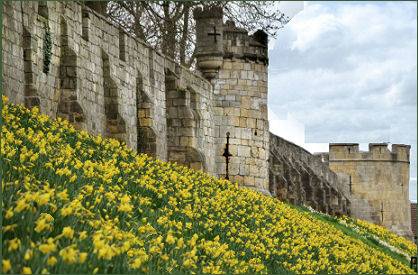
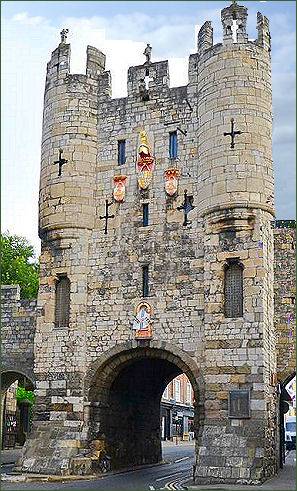 The city walls of York, also known as the Bar Walls, are the most complete example of medieval city walls still standing in England today and extend for 2.5 miles, enclosing a total area of 263 acres.
The city walls of York, also known as the Bar Walls, are the most complete example of medieval city walls still standing in England today and extend for 2.5 miles, enclosing a total area of 263 acres.
York's original city walls were constructed in about 71 AD, when the Romans founded their fort of Eboracum on the site. The fort occupied around 50 acres near the banks of the River Ouse. The rectangle of walls formed part of the Roman fort's defences. The site remained occupied after the decline of the Roman Empire. Two Roman emperors died in Eboracum- Septimius Severus in 211 AD, and Constantius Chlorus in 306 AD.
These fortress defences included four main gateways, and their siting has influenced the street pattern of the city to the present day. The Multangular Tower (pictured below right) , previously known as Elrondyng, which stands in the Museum Gardens, was probably built during the reign of the Emperor Severusis, is the most noticeable and intact structure remaining from the original Roman walls.
The Vikings occupied York, known to them as Jorvik, the city was first captured in November 866 by the fierce Ivar the Boneless, leading a large army of Danish Vikings, known as the "Great Heathen Army" by Anglo-Saxon chroniclers. The Roman defences had by that time deteriorated into a poor condition and were demolished along with the towers, with the exception of the Multangular Tower.
It has been suggested that the south-west gate of the fortress survived within the Viking defences and formed part of a royal palace of the Viking kings of York. The area is now known as King's Square, deriving Old Norse placename 'Konungsgurtha'. This palace may have been used by the legendary Erik Bloodaxe, King of York in 948. New streets, lined by regular building fronts for timber houses were added to an enlarging city between AD 900 and 935, dates arrived at by tree-ring chronology.
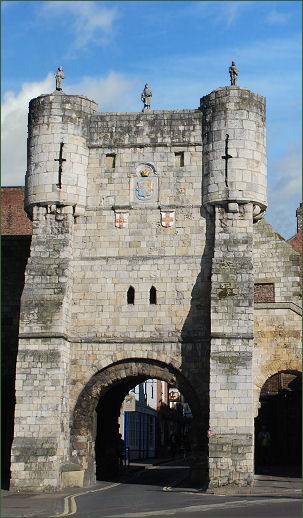
The Multangular Tower is situated in the attractive York Museum Gardens and is the most noticeable and intact structure remaining from the city's Roman walls. It is on the northern side of the gardens, between the Yorkshire Museum and St Leonardís Hospital. The majority of the remaining walls date from the twelfth to the fourteenth century, with some reconstruction carried out in the nineteenth century and later.
The medieval city walls originally included 4 main gates or 'bars', (Bootham Bar, Monk Bar, Walmgate Bar and Micklegate Bar as well as intermediate towers. The name 'bar' has its origins in the bars, barriers, gates which were used to block the gateways.
Following the construction of the medieval city walls, Micklegate Bar, (pictured right) the most westerly entrance to the city, became the primary entrance into York. The name derives from a combination of the Old Norse words 'mykill' (meaning great) and 'gata' (street). In medieval times this entrance to the city was known as "Micklelith". A twelfth century gatehouse was replaced in the fourteenth†century with a heavy portcullis and barbican.†The heavy portcullis and barbican date to the fourteenth century. The gatehouse rises to four stories, the upper two floors contain living quarters and now houses the Henry VII Experience.
The decapitated heads of traitors were once displayed on Micklegate Bar and left to rot. During the dynastic struggle known to us as the Wars of the Roses, following the Lancastrian victory at the Battle of Wakefield, which was fought on 30 December 1460, the heads of Richard Plantagenet, 3rd Duke of York (the father of Kings Edward IV and Richard III) and his seventeen year old second son, Edmund, Earl of Rutland, were displayed on the bar. York's brother-in-law, Richard Neville, 5th Earl of Salisbury, who was captured and executed after the battle, completed the gruesome display. This was done on the orders of the strong willed Lancastrian Queen, Margaret of Anjou whom Shakespeare depicts as saying "Off with his head and set it on York gates; So York may overlook the town of York."
The tallest of York's four gatehouses, Monk Bar, measures 19.2 metres high and dates to the early fourteenth century. was built in the early fourteenth century. It was intended as a self-contained fort, and each floor is capable of being defended separately. The current gatehouse was built to replace a twelfth entury gate known as Munecagate. There were initially three floors, with a fourth added in the fifteenth century. Monk Bar now houses the Richard III Experience, now owned by the Jorvik Group, the exhibition describes the life of King Richard III, England's most controversial king and the last of the great Plantagenet dynasty who ruled England for much of the middle ages. The museum explores Richard's early life, and the bloody battles between the houses of Lancaster and York during the Wars of the Roses. It covers his short eventful reign and his death in battle at Bosworth Field in 1485.
Bootham Bar (pictured left) occupies the site of the porta principalis dextra, the north western gate of Roman Eboracum. It was known in the twelfth century as Barram de Bootham meaning bar at the booths which referred to the nearly market booths. Much of Bootham Bar was constructed in the fourteenth and nineteenth centuries, although it also has some of the oldest surviving stonework, dating to the eleventh century. Bootham Bar was the last of the bars to lose its barbican, which was removed in 1835.
The Red Tower, a Grade I listed building, which dates back to 1490, forms the only brick section of the medieval city walls of York, hence its name.he tower was originally built as part of a programme of improvements to bolster the city's defences, which were agreed by King Richard III and continued by his successor, Henry VII, after Richard's death in 1485 at the Battle of Bosworth The Red Tower was intended as a watchtower to defend the city walls around the vulnerable area around the King's Fishpool, a lake formed by damning the River Foss. In around 1068, William the Conqueror ordered water from the River Foss to be diverted at Fishergate to fill a moat around his castle at York.
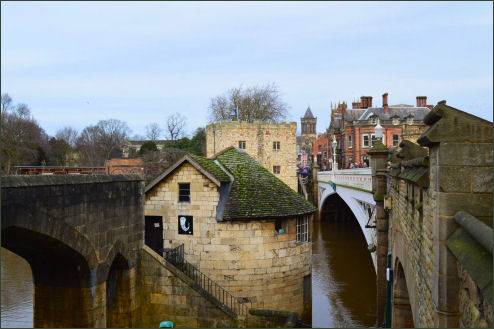
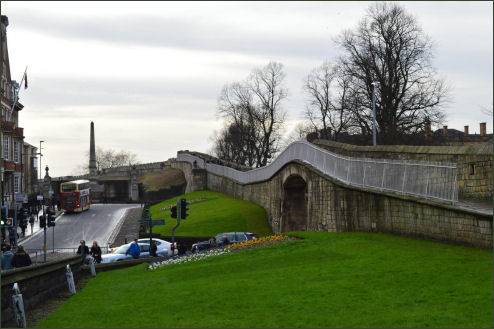
Much of Walmgate Bar was constructed during the fourteenth century, although the inner gateway dates back to the twelfth century. It was originally known as Walbegate, the word Walbe is thought to perhaps derive from an Anglo-Scandinavian personal name. The Bar's barbican, is the only one surviving on a town gate in England. It also retains its portcullis, one of only three surviving in Europe and fifteenth century oak doors. The Bar has been repaired and restored many times over the centuries, most notably in 1648, following the 1644 Siege of York in the English Civil War when it was bombarded by cannon fire.
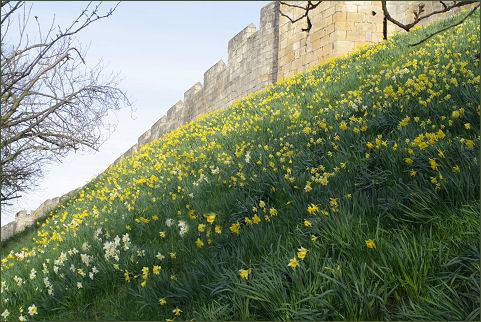
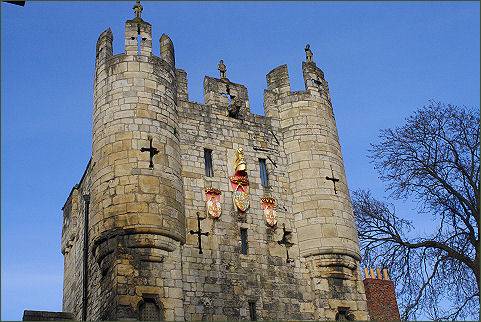
The Bar has been repaired and restored many times over the centuries, It was damaged in 1489 when, along with Fishergate Bar, it was burnt by citizens who were rioting over tax raises imposed by King Henry VII, it needed repairs again in 1648, following the 1644 Siege of York in the English Civil War when it was bombarded by cannon fire, and in 1840 after it had suffered years of neglect.
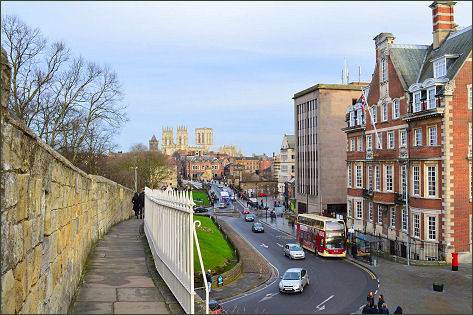
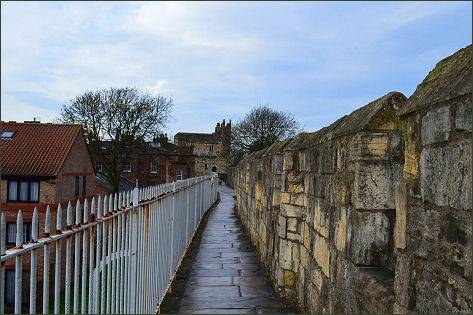
Guide to the Walls
| York City Walls | Bootham Bar | Fishergate Bar | Micklegate Bar & the Henry VII Experience |
| Monk Bar & the Richard III Experience |
The Multiangular Tower |
The Red Tower | Walmgate Bar |
